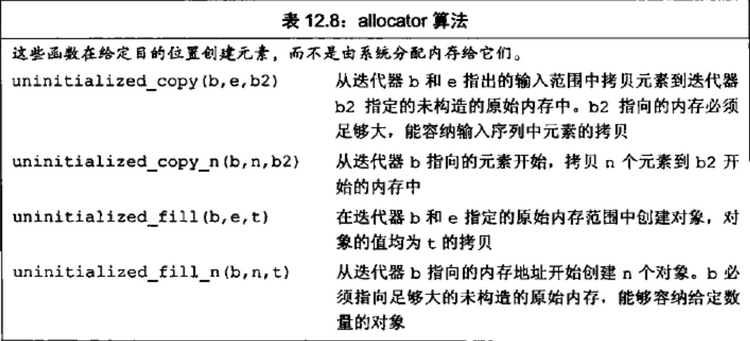标准库中包含一个名为allocator的类,允许我们将分配和初始化分离。使用allocator通常会提供更好的性能和更灵活的内存管理能力。
new有一些灵活性上的局限,其中一方面表现在它将内存分配和对象构造组合在了一起。类似的,delete将对象析构和内存释放组合在了一起。我们分配单个对象时,通常希望将内存分配和对象初始化组合在一起。因为在这种情况下,我们几乎肯定知道对象应有什么值。当分配一大块内存时,我们通常计划在这块内存上按需构造对象。在此情况下,我们希望将内存分配和对象构造分离。这意味着我们可以分配大块内存,但只在真正需要时才真正执行对象的创建操作(同时付出一定开销)。一般情况下,将内存分配和对象构造组合在一起可能会导致不必要的浪费。
标准库allocator类定义在头文件memory中,它帮助我们将内存分配和对象构造分离开来。它提供一种类型感知的内存分配方法,它分配的内存是原始的、未构造的。类似vector,allocator是一个模板。为了定义一个allocator对象,我们必须指明这个allocator可以分配的对象类型。当一个allocator对象分配内存时,它会根据给定的对象类型来确定恰当的内存大小和对齐位置。allocator支持的操作,如下:
allocatro分配的内存是未构造的(unconstructed)。我们按需要在此内存中构造对象。在新标准库中,construct成员函数接受一个指针和零个或多个额外参数,在给定位置构造一个元素。额外参数用来初始化构造的对象。类似make_shared的参数,这些额外参数必须是与构造的对象的类型相匹配的合法的初始化器。
在早期版本的标准库中,construct只接受两个参数:指向创建对象位置的指针和一个元素类型的值。因此,我们只能将一个元素拷贝到未构造空间中,而不能用元素类型的任何其它构造函数来构造一个元素。还未构造对象的情况下就使用原始内存是错误的。为了使用allocator返回的内存,我们必须用construct构造对象。使用未构造的内存,其行为是未定义的。
当我们用完对象后,必须对每个构造的元素调用destroy来销毁它们。函数destroy接受一个指针,对执行的对象执行析构函数。我们只能对真正构造了的元素进行destroy操作。一旦元素被销毁后,就可以重新使用这部分内存来保存其它string,也可以将其归还给系统。释放内存通过调用deallocate来完成。我们传递给deallocate的指针不能为空,它必须指向由allocate分配的内存。而且,传递给deallocate的大小参数必须与调用allocate分配内存时提供的大小参数具有一样的值。
标准库还为allocator类定义了两个伴随算法,可以在未初始化内存中创建对象。它们都定义在头文件memory中,如下:
在C++中,内存是通过new表达式分配,通过delete表达式释放的。标准库还定义了一个allocator类来分配动态内存块。分配动态内存的程序应负责释放它所分配的内存。内存的正确释放是非常容易出错的地方:要么内存永远不会被释放,要么在仍有指针引用它时就被释放了。新的标准库定义了智能指针类型------shared_ptr、unique_ptr和weak_ptr,可令动态内存管理更为安全。对于一块内存,当没有任何用户使用它时,智能指针会自动释放它。现代C++程序应尽可能使用智能指针。
std::allocator是标准库容器的默认内存分配器。你可以替换自己的分配器,这允许你控制标准容器分配内存的方式。
以上内容主要摘自:《C++Primer(Fifth Edition 中文版)》第12.2.2章节
下面是从其他文章中copy的测试代码,详细内容介绍可以参考对应的reference:
#include "allocator.hpp"
#include <iostream>
#include <memory>
#include <string>
#include <vector>
namespace allocator_ {
// reference: C++ Primer(Fifth Edition) 12.2.2
int test_allocator_1()
{
std::allocator<std::string> alloc; // 可以分配string的allocator对象
int n{ 5 };
auto const p = alloc.allocate(n); // 分配n个未初始化的string
auto q = p; // q指向最后构造的元素之后的位置
alloc.construct(q++); // *q为空字符串
alloc.construct(q++, 10, 'c'); // *q为cccccccccc
alloc.construct(q++, "hi"); // *q为hi
std::cout << *p << std::endl; // 正确:使用string的输出运算符
//std::cout << *q << std::endl; // 灾难:q指向未构造的内存
std::cout << p[0] << std::endl;
std::cout << p[1] << std::endl;
std::cout << p[2] << std::endl;
while (q != p) {
alloc.destroy(--q); // 释放我们真正构造的string
}
alloc.deallocate(p, n);
return 0;
}
int test_allocator_2()
{
std::vector<int> vi{ 1, 2, 3, 4, 5 };
// 分配比vi中元素所占用空间大一倍的动态内存
std::allocator<int> alloc;
auto p = alloc.allocate(vi.size() * 2);
// 通过拷贝vi中的元素来构造从p开始的元素
/* 类似拷贝算法,uninitialized_copy接受三个迭代器参数。前两个表示输入序列,第三个表示
这些元素将要拷贝到的目的空间。传递给uninitialized_copy的目的位置迭代器必须指向未构造的
内存。与copy不同,uninitialized_copy在给定目的位置构造元素。
类似copy,uninitialized_copy返回(递增后的)目的位置迭代器。因此,一次uninitialized_copy调用
会返回一个指针,指向最后一个构造的元素之后的位置。
*/
auto q = std::uninitialized_copy(vi.begin(), vi.end(), p);
// 将剩余元素初始化为42
std::uninitialized_fill_n(q, vi.size(), 42);
return 0;
}
// reference: http://www.modernescpp.com/index.php/memory-management-with-std-allocator
int test_allocator_3()
{
std::cout << std::endl;
std::allocator<int> intAlloc;
std::cout << "intAlloc.max_size(): " << intAlloc.max_size() << std::endl;
int* intArray = intAlloc.allocate(100);
std::cout << "intArray[4]: " << intArray[4] << std::endl;
intArray[4] = 2011;
std::cout << "intArray[4]: " << intArray[4] << std::endl;
intAlloc.deallocate(intArray, 100);
std::cout << std::endl;
std::allocator<double> doubleAlloc;
std::cout << "doubleAlloc.max_size(): " << doubleAlloc.max_size() << std::endl;
std::cout << std::endl;
std::allocator<std::string> stringAlloc;
std::cout << "stringAlloc.max_size(): " << stringAlloc.max_size() << std::endl;
std::string* myString = stringAlloc.allocate(3);
stringAlloc.construct(myString, "Hello");
stringAlloc.construct(myString + 1, "World");
stringAlloc.construct(myString + 2, "!");
std::cout << myString[0] << " " << myString[1] << " " << myString[2] << std::endl;
stringAlloc.destroy(myString);
stringAlloc.destroy(myString + 1);
stringAlloc.destroy(myString + 2);
stringAlloc.deallocate(myString, 3);
std::cout << std::endl;
return 0;
}
//
// reference: http://en.cppreference.com/w/cpp/memory/allocator
int test_allocator_4()
{
std::allocator<int> a1; // default allocator for ints
int* a = a1.allocate(1); // space for one int
a1.construct(a, 7); // construct the int
std::cout << a[0] << '\n';
a1.deallocate(a, 1); // deallocate space for one int
// default allocator for strings
std::allocator<std::string> a2;
// same, but obtained by rebinding from the type of a1
decltype(a1)::rebind<std::string>::other a2_1;
// same, but obtained by rebinding from the type of a1 via allocator_traits
std::allocator_traits<decltype(a1)>::rebind_alloc<std::string> a2_2;
std::string* s = a2.allocate(2); // space for 2 strings
a2.construct(s, "foo");
a2.construct(s + 1, "bar");
std::cout << s[0] << ' ' << s[1] << '\n';
a2.destroy(s);
a2.destroy(s + 1);
a2.deallocate(s, 2);
return 0;
}
} // namespace allocator_GitHub: https://github.com/fengbingchun/Messy_Test























 497
497











 被折叠的 条评论
为什么被折叠?
被折叠的 条评论
为什么被折叠?








